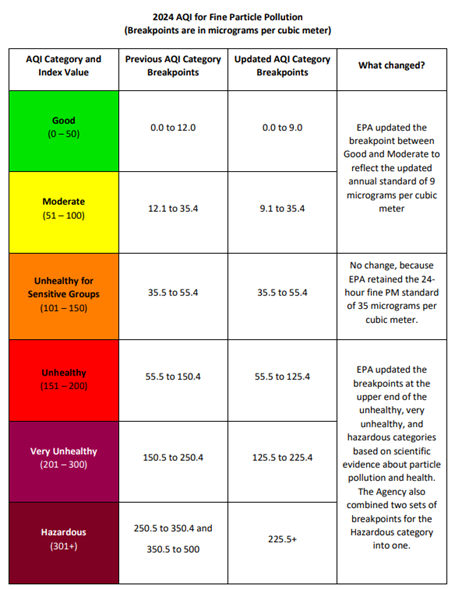You may have noticed over the past month that there seem to be more fine particulate (i.e., PM2.5) readings elevated into the Code Yellow “moderate” range than usual. This is indeed the case but rest assured, air quality has not suddenly worsened in North Carolina. This phenomenon is a result of updated national standards and consequently, a stricter definition of what is considered “good” air quality in terms of particle pollution.
Some Background
Every five years the Environmental Protection Agency (EPA) reviews the National Ambient Air Quality Standards (NAAQS) for each of the six criteria pollutants, as required by the Clean Air Act. These standards define the maximum concentrations of each pollutant allowed within the ambient air that would not cause harm to public health (the primary standards) or public welfare (the secondary standards). Public welfare includes things other than human health such as crops, animals, and infrastructure.
The reviews are done by evaluating the most current science upon which each standard is set, performing risk, exposure, and policy assessments, undergoing public comment and peer review, and then revising or retaining the standard based upon this review.
For NCDAQ’s air quality forecasters, PM2.5 and ozone standards are of particular importance. The Air Quality Index (AQI) incorporates the NAAQS as the breakpoints for several color categories, and so any update to these standards has implications for forecasting. More on that below.
A Revised PM2.5 NAAQS and Updates to the AQI
Following a years-long review process, on May 6 of this year EPA’s revised PM2.5 NAAQS became effective. With this final rule came a new primary annual standard of 9.0 micrograms per cubic meter (µg/m3), which was lowered from the previous value of 12.0 µg/m3. There is also a short-term (i.e., 24-hour) PM2.5 standard that was retained at 35 µg/m3. Although NCDAQ’s meteorologists forecast on a 24-hour basis because of this short-term standard, the AQI scale itself utilizes both the annual and the 24-hour standards as breakpoints for the Good-to-Moderate categories and the Moderate-to-Unhealthy for Sensitive Groups categories, respectively.
Because of this more stringent annual standard, a few changes needed to be made to the Air Quality Index (AQI). Although the AQI scale itself did not change, some of the corresponding concentrations had to be recalibrated. The major repercussions of this updated standard are 1) a tightened range of Good air quality and 2) a wider range of Moderate air quality and 3) a tightened range of Unhealthy air quality which consequently lowered the thresholds for both Very Unhealthy and Hazardous air quality. The table below (courtesy of EPA) nicely summarizes these changes.

What You’ll See in the AIR Tool
The AIR Tool has been updated to reflect the revised PM2.5 standard and the adjusted AQI concentrations. This is most notable on a daily basis when looking at measurements ranging from 9.1 to 12.0 µg/m3 which will now appear as Code Yellow rather than Code Green. For this reason, we expect Code Yellow readings to be more common than they were under the previous standard.

The key takeaway is that North Carolina’s air quality has not suddenly worsened, but rather the range of what is now considered “moderate” air quality has expanded and the range of “good” air quality has tightened. Remember, Code Yellow air quality is acceptable, but there may be a risk for some people who are unusually sensitive to air pollution.
This change will also be reflected in our data measured prior to May 6, 2024. Past data that falls within the 9.1 to 12.0 µg/m3 range will also now appear as Code Yellow within the AIR tool in order to reflect the most current standard. You can visit this site for more information about the revised standard, North Carolina’s current status, and the designation process.
Up Next – The Ozone Standard
The current ozone standard is an 8-hour average at 70 parts per billion (ppb), which was set in 2015 and upheld in 2020. The Clean Air Scientific Advisory Committee (CASAC), an independent group of experts who advise the EPA Administrator on the science behind the NAAQS, has identified new ozone-related research studies and has recommended additional risk analyses in light of the most recent data.
Consequently, in August of 2023 EPA announced a new, full review of the ozone NAAQS and issued a call for information at that time, followed by a public science and policy workshop in May of 2024. Several additional steps will follow, including an Assessment Phase, Integrated Science Assessment report, Risk/Exposure Assessment report, Policy Assessment report, and the Rulemaking process. Information on the ozone NAAQS review process is available on EPA’s website.
 Air Quality Portal
Air Quality Portal